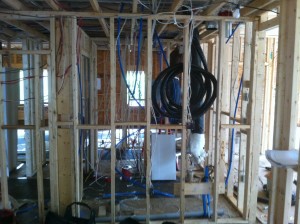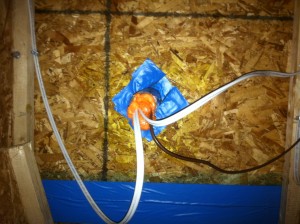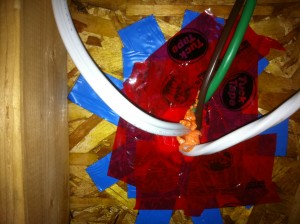 With the mechanical and electrical rough in competed, we had 8 penetrations through the building envelope that we had carefully sealed. So we would know how these holes affected our airtightness and assess our sealing methods, we did another blower door test. A moment of panic hit when the early result was 2.0 ACH, but we quickly realized we hadn’t sealed all the openings to the plumbing stack. Once these were sealed up, we achieved an 0.51 ACH and we were happy we were on the right track.
With the mechanical and electrical rough in competed, we had 8 penetrations through the building envelope that we had carefully sealed. So we would know how these holes affected our airtightness and assess our sealing methods, we did another blower door test. A moment of panic hit when the early result was 2.0 ACH, but we quickly realized we hadn’t sealed all the openings to the plumbing stack. Once these were sealed up, we achieved an 0.51 ACH and we were happy we were on the right track.
We used a couple methods to seal the penetrations. A plumbing pipe was inserted into the hole drilled through the OSB air layer for the electrician and sealed to the wall. Once he ran his wires, we filled the pipe with foam and taped over top. We used the same method for the solar lines into the house. With this pipe we also used a roof flashing boot to seal the pipe to the top of the plywood in the ceiling.
It was harder to seal around the ventilation pipes as they are insulated and covered with plastic wrap. We used red tuck tape to seal on the interior side of the plywood then foamed and sealed with tape on the exterior side of the plywood.
The blower door test showed all these methods worked well with the pipe and flashing boot method being the tightest.



